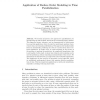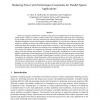3171 search results - page 1 / 635 » Application of Reduce Order Modeling to Time Parallelization |
HIPC
2005
Springer
14 years 1 months ago
2005
Springer
We recently proposed a new approach to parallelization, by decomposing the time domain, instead of the conventional space domain. This improves latency tolerance, and we demonstrat...
CONCUR
1999
Springer
13 years 12 months ago
1999
Springer
Abstract. The paper presents a partial order reduction method applicable to networks of timed automata. The advantage of the method is that it reduces both the number of explored c...
ISCAS
2007
IEEE
14 years 1 months ago
2007
IEEE
— Searching for an efficient summarization of multi-channel electroencephalogram (EEG) behavior is a challenging signal analysis problem. Recently, parallel factor analysis (PAR...
MMAS
2011
Springer
13 years 2 months ago
2011
Springer
While existing mathematical descriptions can accurately account for phenomena at microscopic scales (e.g. molecular dynamics), these are often high-dimensional, stochastic and thei...
IPPS
2005
IEEE
14 years 1 months ago
2005
IEEE
Sparse and irregular computations constitute a large fraction of applications in the data-intensive scientific domain. While every effort is made to balance the computational wor...


